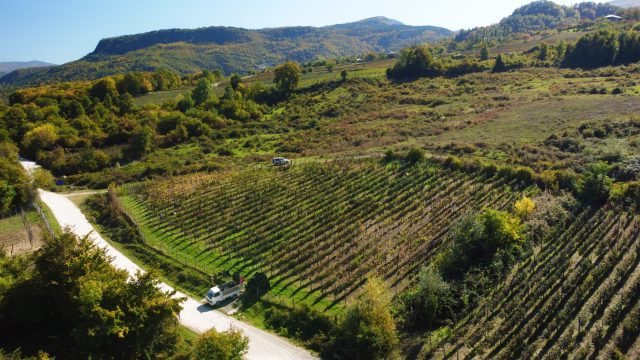Georgian wine poised for growth in US market
Georgian wines are poised for growth in the US market, as consumers interest in skin-contact white wines in the US grows.

American wine consumers are constantly looking for the next new wine discovery. While certainly not “new” in the literal sense, the country of Georgia offers much for wine lovers: incredible history, interesting native grape varieties, fascinating winemaking techniques, diversity in style, as well as great quality and value. Georgia’s winemaking tradition is deeply rooted in its culture. Inseparable from the cuisine and part of get-togethers and celebrations large and small, it is an integral part of the life and soul of the country.
Georgia sits on the eastern edge of the Black Sea at the crossroads of Europe and Asia. Stretching between the Greater Caucasus Mountains to the north and the Lesser Caucasus to the South, this small country is recognized as the birthplace of wine, with winemaking dating back 8,000 years.
But Georgia is not only the birthplace of wine, it is also the birthplace of skin-contact white wines, or amber wines, as Georgia prefers to call them. Interest in these skin-contact whites (also known as orange wines), has been growing worldwide over the past few years, but particularly in the US. They have become the darling of sommeliers, trendy wine shops and natural wine aficionados, and consumers are increasingly noticing the uniqueness, versatility and food-friendliness of this category.
Americans, and the world, are taking notice. According to Wines of Georgia, between 2019 and 2021, Georgia upped the number of exports from close to 93.5 million bottles to more than 107 million bottles, increasing the number of countries it exports to from 57 to 64. Georgian wine exports to the US have grown 29% year-over-year for the last six years, with exports to the US reaching more than one million bottles last year.
Georgia offers something for everyone: in addition to amber wines, consumers can explore everything from the country’s sparkling wines to crisp whites and rosés, from juicy, fresh reds to more age-worthy styles and even semi-sweet wines. Native varieties are used in Georgian winemaking as well as European varieties – and Georgia is home to more than 500 indigenous grape varieties. Nearly 55,000 hectares (nearly 136,000 acres) are under vine, the majority planted in the Kakheti region in eastern Georgia, with 55% planted with white varieties and 45% with red. The two most prominent grape varieties are Rkatsiteli (white) and Saperavi (red). In 2020, there were 25 defined Protected Designations of Origin (PDOs), with wine produced using both traditional Georgian methods as well as European and modern winemaking methods.
Traditional Georgian winemaking makes use of qvevri (large, egg-shaped clay vessels) – and in 2015, archeologists working in southeast Georgia discovered qvevri containing the residue of cultivated grape seeds. Using archeological, archaeobotanical, climatic and chemical methods, these were dated to 6,000 BCE. A subsequent report published in November 2017 by the National Academy of Sciences in the US notes this discovery as the earliest evidence of viniculture and winemaking.

Georgians have made wine in qvevri continuously for 8,000 years, crafted by hand by master qvevri-making families. Often 1,000 or more litres, the qvevri are buried underground to keep temperatures constant during fermentation and aging. Using the traditional method, winemakers ferment the juice and skins together, with this skin contact turning what would otherwise be white wines into amber wines with tannins. Winemakers use qvevri to ferment red grapes as well as white. With the rising popularity of amber and natural wines, the demand for qvevri is on the rise in Georgia and internationally. In 2013, the United Nations added qvevri winemaking to the UNESCO list as “Humanity’s Intangible Cultural Heritage” and in 2021, qvevri was granted Protected Geographical Indication (PGI) status, legally establishing Georgia as the place of origin, and codifying its shape, capacity, raw materials and production method.
Partner Content
This uniqueness in range of wines and styles, combined with Georgia’s winemaking traditions and innovation is key to broadening the number of American fans. Tamar Metreveli, head of marketing and PR for Wines of Georgia, notes how the organization is setting its sights on the US market:
“Our goal is to introduce Georgian wines to a wider audience in the US,” she said. “We are aiming to raise awareness and educate consumers, highlighting the history, culture and quality of Georgian winemaking, and accentuating the wines’ outstanding value and versatility in food pairings and year-round consumption.”
Levan Mekhuzla, chairman of Georgia’s National Wine Agency, agrees.
“Georgia has an incredible winemaking history and culture. We are looking forward to increasing visibility and awareness of and engagement with Georgian wines in the United States, a key export market with great potential for growth,” he said. “Our country’s wineries are producing high-quality wines, with a link to the past and a look toward the future, which are worthy of increased attention from American wine consumers. Now is the time to bring this awareness to the United States.”
About Colangelo & Partners
Colangelo & Partners is the leading fine wine and spirits-focused PR agency in the US offering five basic services: press relations, social media/ influencer marketing, event marketing, trade relations, and content marketing. With main offices in New York and San Francisco, Colangelo & Partners has an international team of PR professionals who are technically trained and certified in wine and spirits as well as the disciplines of communications.
Related news
For the ninth day of Christmas…




